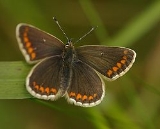
Northern Brown Argus
Encyclopedia
The Northern Brown Argus (Aricia artaxerxes) is a butterfly
in the family Lycaenidae
.
 This species has confused British entomologists for years. Since its discovery in Britain it has been thought to be a form or a subspecies of the Brown Argus
This species has confused British entomologists for years. Since its discovery in Britain it has been thought to be a form or a subspecies of the Brown Argus
Aricia agestis and as well as a species in its own right. Since 1967 all Brown Argus in the north of England and Scotland have been classified as this species. In the last few years genetic studies have shown that some of the colonies along the border of the two species ranges are still being wrongly classified and some colonies in the north of England are now thought to be A. agestis. So far as is known their ranges do not overlap in the UK. The Scottish form is visually quite distinct from the Brown Argus. It usually has a small white dot in the centre of the upper side fore wing and the black spots on the underside are missing leaving larger white spots on the light brown background. The northern English populations belong to a form called salmacis and are very similar to the Brown Argus including the presence of black spots on the under-wing (see photo) hence all the confusion. On the continent, where it is known as the Mountain Argus, it is widespread in Scandinavia and mountainous regions of central, southern and Eastern Europe. The species is considered locally rare in Britain, and the UK has established a detailed Biodiversity Action Plan
to conserve this species along with a small number of other butterfly species.
while still quite small and continue to feed and grow the following spring. Like the Brown Argus, it is attractive to ants and often attended by them. Pupation takes place at ground level in late May and butterflies are on the wing from mid June to mid July.
Butterfly
A butterfly is a mainly day-flying insect of the order Lepidoptera, which includes the butterflies and moths. Like other holometabolous insects, the butterfly's life cycle consists of four parts: egg, larva, pupa and adult. Most species are diurnal. Butterflies have large, often brightly coloured...
in the family Lycaenidae
Lycaenidae
The Lycaenidae are the second-largest family of butterflies, with about 6000 species worldwide, whose members are also called gossamer-winged butterflies...
.
Appearance, behaviour and distribution

Brown Argus
The Brown Argus is a butterfly in the family Lycaenidae.-Appearance, behaviour and distribution:Although one of the "Blues" both sexes are brown on the uppersides with a band of orange spots at the border of each wing...
Aricia agestis and as well as a species in its own right. Since 1967 all Brown Argus in the north of England and Scotland have been classified as this species. In the last few years genetic studies have shown that some of the colonies along the border of the two species ranges are still being wrongly classified and some colonies in the north of England are now thought to be A. agestis. So far as is known their ranges do not overlap in the UK. The Scottish form is visually quite distinct from the Brown Argus. It usually has a small white dot in the centre of the upper side fore wing and the black spots on the underside are missing leaving larger white spots on the light brown background. The northern English populations belong to a form called salmacis and are very similar to the Brown Argus including the presence of black spots on the under-wing (see photo) hence all the confusion. On the continent, where it is known as the Mountain Argus, it is widespread in Scandinavia and mountainous regions of central, southern and Eastern Europe. The species is considered locally rare in Britain, and the UK has established a detailed Biodiversity Action Plan
Biodiversity Action Plan
A Biodiversity Action Plan is an internationally recognized program addressing threatened species and habitats and is designed to protect and restore biological systems. The original impetus for these plans derives from the 1992 Convention on Biological Diversity...
to conserve this species along with a small number of other butterfly species.
Life cycle and Food plants
Eggs are laid singly on the upperside of the food plant leaves. As far is known Common Rock-rose Helianthemum nummularium seems to be the sole food plant in Britain. The larvae hibernateHibernation
Hibernation is a state of inactivity and metabolic depression in animals, characterized by lower body temperature, slower breathing, and lower metabolic rate. Hibernating animals conserve food, especially during winter when food supplies are limited, tapping energy reserves, body fat, at a slow rate...
while still quite small and continue to feed and grow the following spring. Like the Brown Argus, it is attractive to ants and often attended by them. Pupation takes place at ground level in late May and butterflies are on the wing from mid June to mid July.

